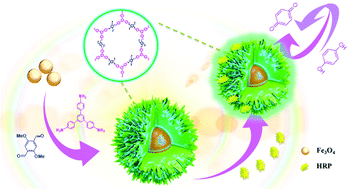A highly sensitive electrochemical biosensor for the detection of hydroquinone based on a magnetic covalent organic framework and enzyme for signal amplification
Abstract
Possessing prominent customization in structural design as well as unique physicochemical properties, covalent organic frameworks (COFs) show great potential in the biosensing field. In this study, we prepared a novel COF-based electrochemical enzymatic composite (denoted as Fe3O4@COF@HRP), where spherical magnetic COF was functionalized with horseradish peroxidase (HRP). The resultant composite was characterized by X-ray diffraction, Fourier transform infrared spectroscopy, X-ray photoelectron spectroscopy, and transmission electron microscopy. Thereinto, the Fe3O4 nanoparticles with remarkable conductivity could accelerate the charge transfer, while HRP with good catalytic activity could enhance the sensitivity of the as-prepared biosensor. With such a design, the Fe3O4@COF@HRP-based biosensor exhibits excellent analytical properties for the determination of hydroquinone. The extended linear detection range was 0.5–300 μmol L−1, and the limit of detection was down to 0.12 μmol L−1 (S/N = 3). Furthermore, the electrochemical enzymatic biosensor was used to detect low-abundance hydroquinone in environmental water samples with a satisfactory consequence, suggesting great promise in sensing applications.



 Please wait while we load your content...
Please wait while we load your content...